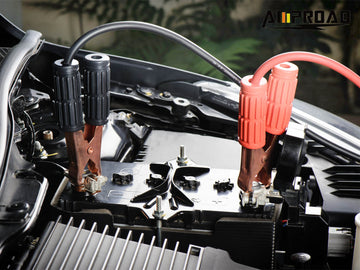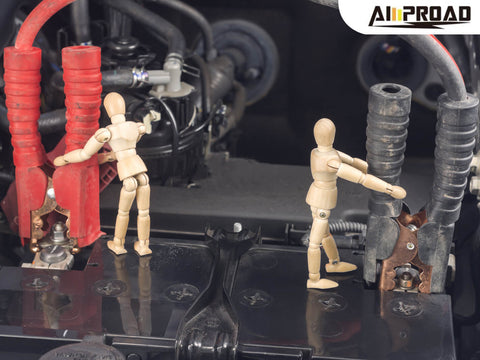
Experiencing a dead car battery can quickly turn a good day into a frustrating one. Whether you find yourself stranded in a parking lot or stuck on the side of the road, knowing how to jump-start your vehicle can be a lifesaver. In this comprehensive guide, we'll walk you through the safest and most reliable methods for jump-starting a car. Whether you opt for traditional jumper cables and a friendly neighbor or prefer the convenience of a portable jump starter, we'll cover everything you need to know to get your vehicle back on the road quickly and safely. So, let's dive in and learn the ropes of jump-starting your car like a pro!
Safety First
Safety is paramount when jump-starting a vehicle. Before you even think about connecting cables or a portable jump starter, make sure you’re in a safe environment. Park both vehicles on a level, stable surface away from traffic. Engage the parking brakes and turn off both engines. Keep the jumper cables and the portable booster batterie ready, and ensure everyone involved is clear on the process.
General Safety Tips:
- Read the Manual:Always consult your vehicle’s owner manual and the jump starter manual before attempting to jump-start the car.
- Avoid Sparks:Keep sparks, flames, and cigarettes away from the battery at all times.
- Protect Your Eyes:Wear safety glasses to protect your eyes from potential battery acid splashes.
- Check for Damage:Ensure the battery isn’t cracked or leaking before attempting to jump-start.
Jumper Cables: Teamwork Makes the Dream Work
This traditional method relies on the kindness of a stranger with a vehicle sporting a compatible battery (usually 12 volts) and a set of jumper cables. Here’s how to boost a car using jumper cables effectively:
Gear Up
Locate good quality jumper cables with thick gauge wires (ideally 6 or lower) to handle the current effectively. The quality of the cables can make a significant difference in how quickly and safely you can jump-start your car.
Cable Connections
Identify the positive and negative terminals on each battery. Positive terminals are typically marked with red and a "+" symbol. Connect the red clamp of one cable to the positive terminal of the dead battery. Then, connect the other red clamp to the positive terminal of the good battery.
Crucial Step
Find the negative terminal on the good battery and connect a black clamp from the jumper cable to it. Important note: Do not connect the final black clamp to the negative terminal of the dead battery yet.
Grounding Point
Locate a clean, unpainted metal grounding point on the dead car, away from the battery (like a bolt on the engine block). Clamp the final black cable to this grounding point. This step is crucial as it helps prevent sparks that can occur if the negative clamp is connected directly to the dead battery’s terminal.
Power Up the Helper
Start the vehicle with the good battery and let it run for a few minutes. This allows its alternator to replenish some power into the dead battery. The length of time can vary, but typically, letting it run for 5-10 minutes is sufficient.
Give it a Try
Now, try jump start the car with the dead battery. If it cranks but doesn’t turn over, wait a few more minutes and try again. Sometimes it takes a little while for enough charge to build up in the dead battery to start the engine.
Success!
Once the dead car starts, remove the jumper cables in the reverse order they were connected (black ground first, then black negative, red positive). Make sure the clamps do not touch each other during this process, as it can create dangerous sparks.
Portable Jump Starter: Solo Savior

For those who prefer a one-person operation, a portable jump starter offers a convenient alternative. These compact devices pack a powerful punch, delivering enough current to jump-start most engines. Here’s how to use a portable jump starter:
Be Prepared
Make it a habit to confirm your portable jump starter's full charge before stowing it in your vehicle. Periodically inspect its charge level and replenish it if needed. A properly maintained jump starter is invaluable during unexpected emergencies, ensuring you're equipped to tackle any roadside battery mishaps with confidence and ease.Simple Connections
Most jump starters follow similar procedures. Consult your device’s manual, but typically, you’ll connect the positive clamp to the positive terminal of the dead battery and the negative clamp to a grounding point on the engine block. Some modern jump starters also come with safety features that prevent incorrect connections.
Jumpstart Time
Turn on the jumping starter following the manufacturer’s instructions and attempt to start your car. Most portable jump starters have an on/off switch and an indicator light to show they are ready to use.
Disconnect
Once the car starts, disconnect the jump starter following the recommended order. Typically, you’ll remove the negative clamp first, then the positive. Ensure that the clamps do not touch each other during removal.
Advantages of Portable Jump Starters:
- Independence:With a portable jump starter, you don't have to rely on another vehicle being nearby. This independence can be crucial in remote areas or when you're alone on the road.
- Compact and Portable:These devices are designed to be lightweight and easy to store in your car. Their small size means you can keep them in the trunk or glove compartment without taking up much space.
- Additional Features:Many portable battery boosters come with extra features that can come in handy during emergencies. These may include built-in flashlights for nighttime use, USB ports for charging electronic devices, and even air compressors for inflating tires. Having these additional functionalities in a single device makes it a versatile tool for various roadside situations.
Important Reminders
Vehicle Safety
When jump-starting a vehicle, it's crucial to prevent the vehicles from touching each other. This precaution is essential because contact between the vehicles can create electrical interference, potentially damaging their electronic systems. Additionally, make sure that the jumper cables or jump starter cables do not dangle near moving parts of the engine, such as belts or fans. Secure the cables away from these components to avoid any accidents or damage to the vehicle. By maintaining a safe distance between vehicles and ensuring the cables are properly secured, you can mitigate the risk of electrical hazards and mechanical damage while jump-starting your car. Always prioritize safety to prevent accidents and protect both yourself and your vehicle from harm.
Battery Terminal Connection
With either method, avoid connecting the black clamp to the negative terminal of the dead battery. This can cause sparks and potentially an explosion. Always connect the black clamp to a solid, unpainted metal surface away from the battery.
Persistent Problems
If the car doesn’t start after multiple attempts, there might be a more serious issue. Consider calling for roadside assistance. It’s possible that the battery is beyond charging, or there could be an underlying issue with the vehicle’s electrical system.
Maintenance and Care
Regularly check your car battery’s health to avoid unexpected dead battery situations. Many auto parts stores offer free battery testing and can tell you if your battery needs to be replaced.
Environmental Considerations
Batteries contain harmful chemicals and should be disposed of properly. Check with your local waste disposal service for guidelines on recycling or disposing of old batteries.
Choose the Right Method for Your Needs

By following these steps and prioritizing safety, you can choose the jump-starting method that best suits your situation and get back on the road in no time. Whether you opt for the traditional jumper cables and the assistance of another driver, or the independence offered by a portable jump starter, understanding the correct procedure is key to a safe and successful jump start.
Traditional Teamwork
The classic method involves jumper cables and a good Samaritan with a compatible vehicle battery (usually 12 volts). Remember to use high-quality jumper cables with thick gauge wires (ideally 6 or lower) to ensure they can handle the current effectively. Here's where the AMPROAD Portable Jump Starter comes in handy for those who might not always have a helping hand around.
AMPROAD: Your Portable Powerhouse
The AMPROAD Portable Jump Starter is a compact and powerful solution for solo drivers. It packs a punch, delivering enough current to jumpstart most engines, making it a reliable companion in your car. Ensure your AMPROAD Jump Starter is fully charged before storing it in your vehicle. This way, you'll be prepared to tackle a dead battery situation with confidence, no matter where the road takes you.
Remember: Safety always comes first. Proper preparation, understanding the steps involved, and regular maintenance of your jumper cables or portable jump starter can make all the difference. With the right knowledge and tools, you can handle a dead battery with confidence and ease, ensuring a smooth journey even when faced with an unexpected setback.



